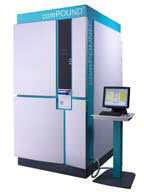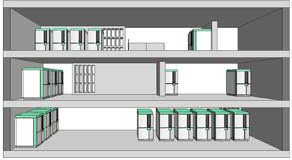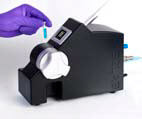Summary In the article, we introduce an innovative large-scale compound management method in tube storage that maximizes laboratory space use efficiency and ensures compound stability for any individual compound-pick. At the same time, it has quality control and new compound submission and storage functions. Richard Kim, Ben Schenker, Simon Tullett, Chloe Carter Introduction Current compound management has evolved to support primary screening and rescreening projects with a centralized library of compounds that store a variety of plates and tubes. The low efficiency of storage in the form of tubes and plates increases the complexity of these compound libraries, making them very expensive to use and, more importantly, difficult to expand or relocate. At the same time, the submission of new samples into the system becomes a drag-and-drop process, which can delay the high-throughput screening (HTS) of the sample for several months. Board-style storage is often considered the only way to support primary screening throughput requirements. However, with this method, the integrity of the sample will be compromised due to the inevitable exposure of the sample to the environment and repeated freeze-thaw cycles. In addition, quality control of the board is almost impossible, it can lead to false positives and false negatives, which can only be identified by the rescreening stage. Compound storage in the form of plates also limits the flexibility of the compound library, and the entire library needs to be screened in every high-throughput screening operation. A more efficient primary screening method is to screen only the portion of the compound library that is associated with the target compound, but this requires the compound library to have a cherry-pick function. In the article, we introduce an innovative large-scale compound management method in tube storage that maximizes laboratory space use efficiency and ensures compound stability for any individual compound-pick. At the same time, it has quality control and new compound submission and storage functions. 1. The past and present of compound storage In the past, compound storage systems were usually identified at the beginning of the purchase, and the size of the library had to be known before debugging the system. In view of conventional storage containers, storage systems are typically designed to accommodate a variety of containers, which greatly reduces system throughput. As automation becomes more intelligent, the standardization of storage container forms is no doubt more meaningful, as it increases the reliability of the storage system, increases throughput, speeds up, and eases the burden of sample management. Today, we can specify the minimum requirements for automated storage systems, and many vendors offer “modular†storage devices that allow users to upgrade and scale as needed. However, there is still a misconception that although the primary screening compounds are stored in tubes to ensure sample integrity, each sample must be transferred to ready-to-use plate storage to meet the throughput requirements of the screening. 2. Stability of compounds in tubes and plates Several factors influence the quality of stored compound samples, including: Allowing a single compound sample in a tube or plate to be in a low temperature, dark, dry, and inert atmosphere will significantly reduce the effects of these factors and achieve long-term storage of the sample. However, even if the compound is in the above environment, repeated freeze-thaw and exposure to air will still impair the integrity of the sample. If a single sample picked up is taken from the system (cherry-pick) when the sample is taken, this effect can be greatly reduced. However, if the sample is stored in the form of a plate, the sample in the plate must be completely thawed and exposed to the air to obtain a single sample, which is obviously disadvantageous for long-term storage of the sample. 3. Future compound storage The comPOUND automated storage system from TTP Labtech guarantees sample integrity and picks up individual tube-pick samples at ultra-high speeds. Each comPOUND is set as a separate module for storage conditions. As the compound library expands, multiple comPOUNDs can be connected to expand the system's storage capacity. When more modules are added to the system, sample extraction is faster because multiple comPOUNDs pass samples at the same time. Samples taken from comPOUND can be transferred remotely so that the instrument does not need to be placed in the laboratory. 4. Ultra high throughput selection It is generally believed that samples must be stored in plates to meet the throughput required for very large sample libraries. However, the comPOUND/comPILER system is able to select the samples required for each screening directly from the initial screening library while preserving sample integrity. Practice has shown that only 10 comPOUND storage systems can process 20,000 sample tubes in 8 hours. 5. Extension The flux of the comPOUND system can reach steady state quickly, so it is easy to achieve 24-hour operation or add more modules. The table below shows the possible fluxes: 6. Maximize laboratory space utilization efficiency TTP Labtech's LAB2LAB system integrates with the comPOUND system to automatically take a single tube from the storage system and send it to HPLC, GC/MS or NMR for analysis. Unconventional screening results are quickly detected and provide comprehensive feedback in minutes. in conclusion For more information on comPOUND, please visit the official website of Tengquan. Laboratory Sterilizer,Laboratory Sterilizers,Laboratory Steam Sterilizer,Lab Sterilization Equipment ZHEJIANG FOMOS MEDICAL TECHNOLOGY CO.,LTD. , https://www.ifomos.com
TTP Labtech Ltd, Melbourn Science Park, Melbourn, Hertfordshire, SG8 6EE, UK
• Physical pollution (dust)
• Decomposition caused by light • Concentration (evaporation)
• O2 reaction • H2O dilution or reaction • Precipitation • Repeated freezing and thawing 

The above table assumes that a 1.4 mL tube is stored. If a 0.5 mL tube is stored, the flux will double.
A large number of comPOUND systems can be placed where the user deems it convenient, and the sample tubes can be transported to the point of use (remote transmission) using pneumatic technology. 
7. Compound quality control
Transferring the right compound at the right time is only part of the working process of the storage system. Understanding the volume and quality of the compound is equally important, but it has been difficult to achieve. 
The proven comPOUND sample tube storage system enables true arbitrary single-picking (picry-picking) while meeting speed and throughput requirements. Sample extraction in this manner maximizes sample integrity and is suitable for a wide range of compound libraries. The integration of comPOUND with LAB2LAB gives end users complete automated sample storage and analysis capabilities.